The Virtual Vocations “2023 Remote Work Statistics” report names 20 trends for the year ahead. This data is applicable to jobseekers considering remote jobs as well as employers and hiring managers evaluating their remote work policies.
Remote work conversations have changed. They are no longer about when remote work will become the preferred work arrangement, but rather how to make virtual employment options more accessible and permanent. This shift has been fueled by the demand for remote jobs by workers desirous of more control over how, when, and where they work.
Workers want to save money by not commuting, perform at peak productivity from their home offices, and enjoy better personal health and well-being from the comfort of their homes. In fact, workers in 2022 wanted these remote work benefits so much that the were willing to choose work from home job options above compensation, workplace recognition, and opportunities for promotion and advancement. Access to remote jobs is the top concern among workers, and it should be for employers, too. Remote-first organizations were the least impacted businesses during the Great Resignation.
Considering What Workers Want in 2023
When we look to the motivations and mindsets of U.S. professionals as they begin to plan their job searches in 2023, we see evidence of continued interest and urgency for remote work:
- 71% believe their employers ask too much of them.
- 67% feel professionally burned out or have recently experienced job burnout.
- 63% have felt less professionally motivated or engaged since the onset of the COVID-19 pandemic.
- 55% would consider quiet quitting.
- 45% say their level of work-related stress has increased somewhat or substantially since 2021.
- 29% have changed jobs within the past year; an additional 9% actively looking for their next role.
- 20% said they are not confident in their employer’s ability to prioritize their well-being.
To learn more about what workers want from their careers, how remote work continues to influence the U.S. workforce, and ways employers can grow their organizations with remote-first policies, we looked within and without to gather and analyze the latest remote work data for 2023.
CEO’s Statement on Our 20 Trends to Know
“The 2023 remote work statistics we uncovered depict a U.S. workforce eager to maintain and expand their access to remote jobs in the new year. Workers are burned out, disengaged, stressed, and willing to leave their jobs to find better, more flexible opportunities.
Since March 2020, both employees and employers have been forced to more closely examine the benefits of remote work. Employees, in particular, used their time working remotely during the COVID-19 pandemic to also reexamine their personal values and lifestyles. This period of self-assessment continued through 2021 and 2022, inspiring trends like the Great Resignation and quiet quitting. Even amid growing economic uncertainties, including rising inflation and a possible global recession, employees are still exercising their power to choose work that not only rewards them financially but also fulfills them personally.”

2023 Remote Work Statistics — 32,000 Workers Surveyed
We gathered the 2023 remote work statistics for this report from both internal and external surveys. In total, these surveys polled more than 32,000 U.S. workers on their remote work opinions and thoughts concerning how they imagine flexible employment fitting into, as well as improving, their lives and careers. The findings have been divided into the following five core 2023 remote work statistics categories:
- The Prevalence of Remote Work
- The Environment of Remote Work
- The Impact of Remote Work
- The Challenges of Remote Work
- The Future of Remote Work
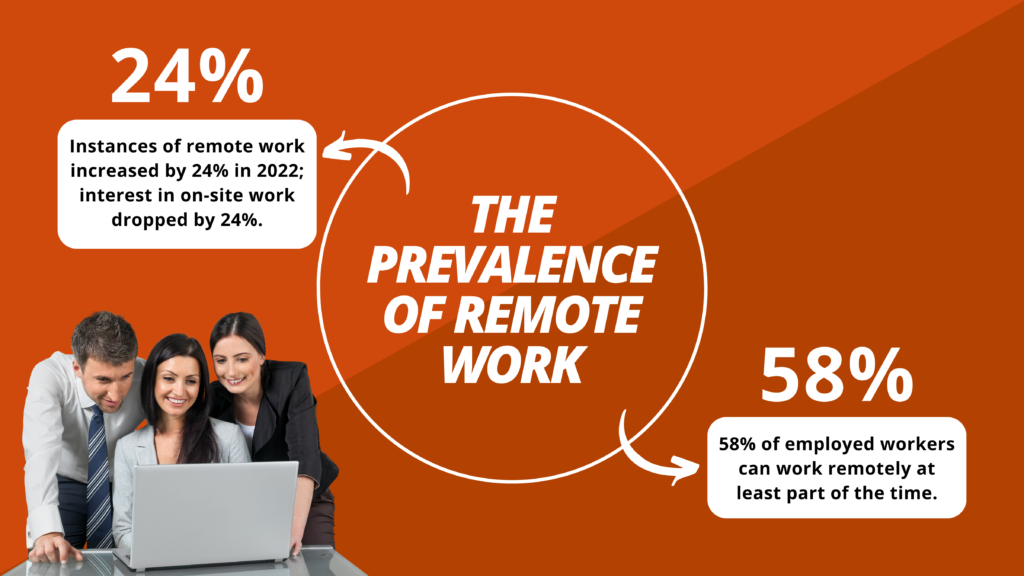
The Prevalence of Remote Work — 2023 Remote Work Statistics
1. The number of workers choosing to work remotely in 2022 increased 24%. Meanwhile, interest for on-site work dropped by 24%.
(Owl Labs)
2. 58% of employed workers—approximately 92 million Americans—can work remotely at least part of the time.
(McKinsey & Company)
3. Remote work opportunities have increased in practically every industry, but workers in digitally innovative fields, like computers and mathematics, have greater access; 77% of professionals in these fields can work from home 100% of the time.
(McKinsey & Company)
4. If presented with the opportunity to work remotely, 87% of workers take up employers on the offer.
(McKinsey & Company)
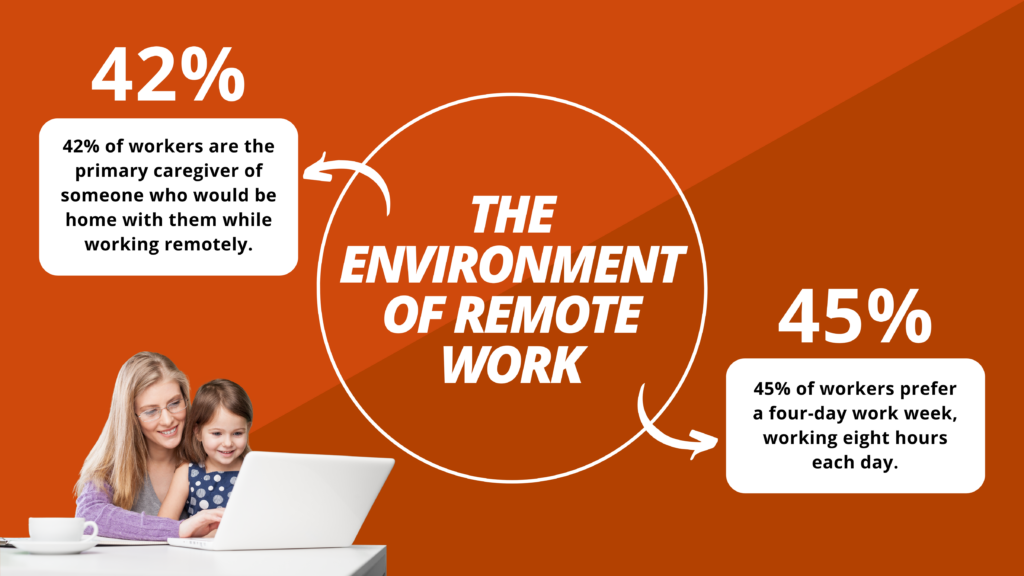
The Environment of Remote Work — 2023 Remote Work Statistics
5. 62% of workers want to work from home 100% of the time.
(Virtual Vocations)
6. 45% of workers prefer a four-day work week, working eight hours each day. They feel they can be just as productive working 32 hours per week.
(Virtual Vocations)
7. 42% of workers are the primary caregiver for a loved one who would be home with them while working remotely.
(Virtual Vocations)
8. 64% of workers say their ideal remote work location is a dedicated home office.
(Virtual Vocations)
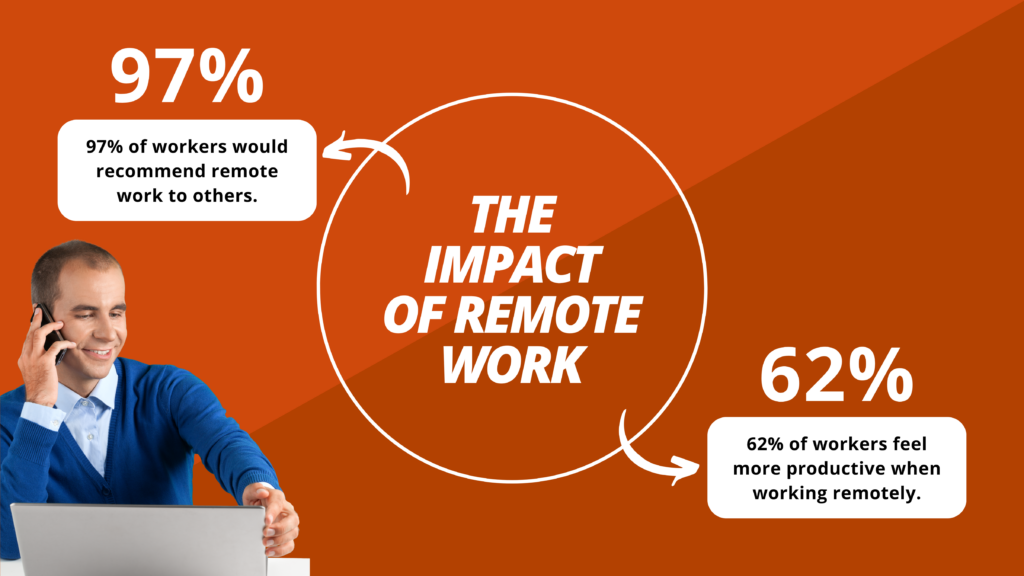
The Impact of Remote Work — 2023 Remote Work Statistics
9. “Very positive” is how 61% of workers describe their experiences with remote work. Overall, 90% would describe their experience as at least “somewhat positive.”
(Buffer)
10. 97% of workers would recommend remote work to others.
(Buffer)
11. 62% of workers feel more productive when working remotely.
(Owl Labs)
12. If the ability to work from home was taken away, two-thirds (66%) of workers would immediately start looking for a job that offered flexibility. Under the same circumstances, 39% would quit.
(Owl Labs)
13. 52% of workers would take a pay cut of 5% or more to have flexibility in working location; 23% would take at least a 10% pay cut.
(Owl Labs)
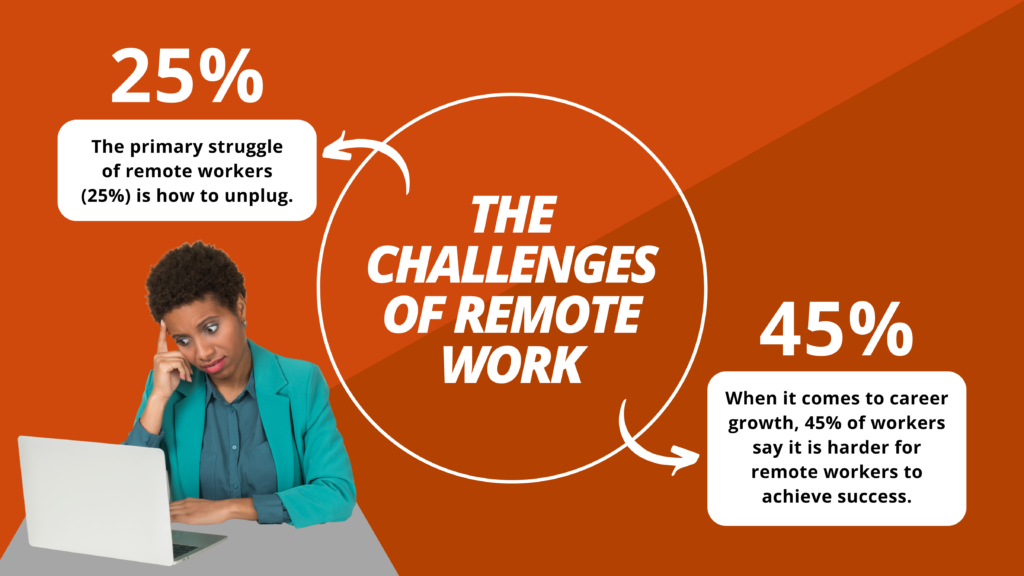
The Challenges of Remote Work — 2023 Remote Work Statistics
14. The primary struggle of remote workers (25%) is not being able to unplug.
(Buffer)
15. Within their existing workplaces, 20% of workers are most concerned about access to remote jobs.
(Virtual Vocations)
16. 62% of workers say their company does not have an asynchronous-first work policy. These policies prioritize online communication and collaboration methods, including email and apps like Slack, over meetings.
(Buffer)
17. When it comes to career growth, 45% of workers think it is more difficult for remote workers to achieve success.
(Buffer)
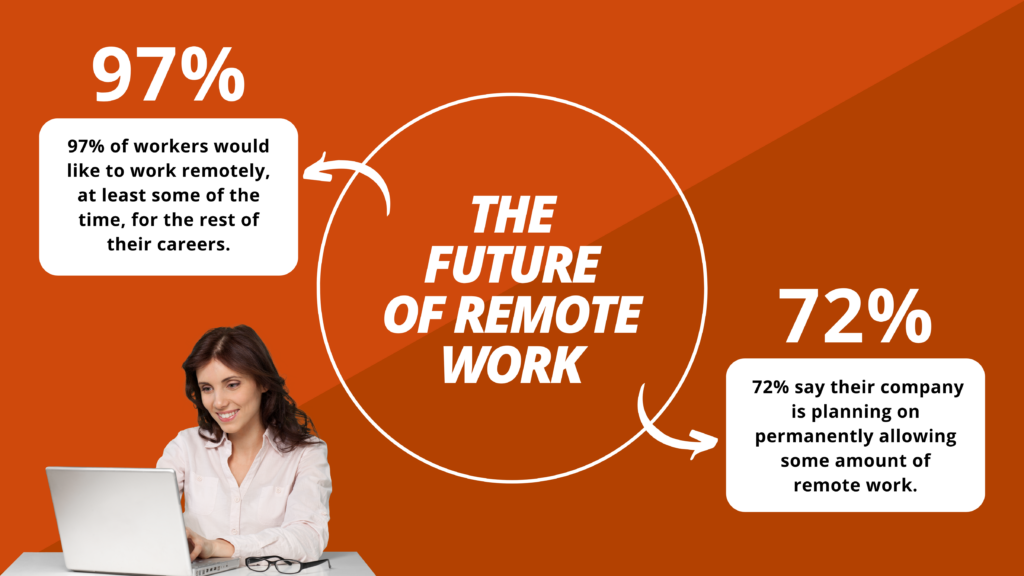
The Future of Remote Work — 2023 Remote Work Statistics
18. 97% of workers would like to work remotely, at least some of the time, for the rest of their careers.
(Buffer)
19. Access to remote job options would make 69% of workers less likely to quiet-quit their jobs in the future.
(Virtual Vocations)
20. 72% say their company is planning on permanently allowing some amount of remote work. Compared to answers to the same question asked in 2021, the number of “Yes” responses increased by 26 percentage points..
(Buffer)
Sources

In Buffer’s “2022 State of Remote Work” report, the company surveyed 2,118 people from 16 countries. Questions polled remote workers on shifts made in and the evolution of remote work in recent years. For its fifth annual report, Buffer grappled with how to best showcase changes to the scope of work since the beginning of the COVID-19 pandemic. After all, the pandemic pushed many workers and companies into working primarily from home or entirely modifying their work models.

McKinsey & Company collaborated with the market-research firm Ipsos to for the 2022 “American Opportunity Survey.” This poll, which ran from March 15–April 18, 2022, surveyed 25,000 Americans in English and Spanish. Participants, who were adults age 18 and older, resided in the continental United States, Alaska, and Hawaii at the time of the survey.
The goal of the “American Opportunity Survey” was to shine light on how many workers are actually given opportunities to work from home, as well as find out which professionals work flexibly and how they feel about these options. This was the third edition of McKinsey’s “American Opportunity Survey” querying a representative cross section of U.S. workers.

Owl Labs collaborated with Global Workplace Analytics, a leading remote work consulting firm, for its 6th annual “State of Remote Work” report. In July 2022, the companies surveyed more than 2,300 full-time U.S. workers to learn their onsite, hybrid, and remote work requirements, concerns, and preferences.

Upwork’s “Future Workforce Report 2022” is a representative survey of 1,000 U.S. hiring managers. The survey results reveal how businesses met their staffing needs over the past two-and-a-half years by adapting their hiring and workplace practices, including increasingly relying on skilled independent talent. Upwork’s data also explores how hiring managers are preparing to withstand continued talent shortages.

On February 1, 2022, Virtual Vocations updated our job posting policy to solidify our status as a 100% virtual job board. This shift to sharing only fully remote jobs was inspired by jobseeker feedback, but we wanted to learn more about how current and potential remote workers perceive fully remote position, as well as what they want from 100% virtual jobs. The survey results outlined in this report reveal modern workers’ opinions on 100% remote jobs, their views on flexibility in the workplace, and what concerns them most about life as an employee in 2022. From March 13–18, 2022, we received more than 540 responses from current and potential remote jobseekers eager to weigh in on how they define a 100% remote job and what they want from a remote career.

What do workers want most from employers in 2022? We answered this question by surveying nearly 400 working-age adults, from January 3 – 8, 2022, on their opinions concerning what would make them happiest in their jobs. Read our “Job Satisfaction Survey” report to discover modern workers’ job satisfaction levels, their most desired benefits and job perks, workers’ access to remote job options amid COVID-19, and the impact the pandemic has had on workers’ job outlooks. Our Job Satisfaction Survey was offered to Virtual Vocations members as well as to the general public, and all survey responses were submitted voluntarily.

Professional burnout is real and it has inspired workers to quiet-quit their jobs. At Virtual Vocations, we wondered, is quiet quitting the solution to stopping hustle culture or is quiet quitting merely a symptom of employees feeling undervalued in their jobs?
October 11-13, 2022 marked Virtual Vocations’ seventh annual celebration of National Work and Family Month. During the event, Virtual Vocations polled 650 workers with a “Quiet Quitting Survey” on their opinions about quiet quitting, hustle culture, professional burnout, and what motivates them most at work. Throughout the celebration, we sought to position remote work as a solution to the rising trend of quiet quitting. With an event theme of “Quit the Hustle, Embrace Remote Work,” the goal was to celebrate remote work and how it helps professionals quit hustle culture as well as embrace a more healthy and productive work-life balance in the U.S. and around the world.
About Virtual Vocations
Virtual Vocations, Inc., founded in 2007, is a private, family-owned, and 100% distributed company. Co-founded by CEO Laura Spawn and her brother, CTO Adam Stevenson, Virtual Vocations connects jobseekers with legitimate, fully remote job openings screened to ensure the highest quality standards. To date, Virtual Vocations has helped more than four million jobseekers find flexible remote work options.
In addition to managing and curating a database that, at any given time, houses more than 15,000 current, hand-screened remote job openings, Virtual Vocations offers jobseekers a number of tools to aid in their job searches. These tools include exclusive, self-paced career courses, digital guides for popular virtual job industries, downloadable worksheets, job coaching and interview prep, LinkedIn profile enhancement, and resume and cover letter writing services. What’s more, Virtual Vocations also releases multiple data-driven reports each year on current trends in remote work.
Send questions about Virtual Vocations’ “2023 Remote Work Statistics” report to Kimberly Back, Senior Job Data Content Producer, at kim (at) virtualvocations (dot) com. Please visit Virtual Vocations’ social media profiles on Facebook, Twitter, LinkedIn, YouTube, Instagram, and Pinterest for more remote work content and conversations.
Additional Image credits: Canva; Virtual Vocations images prepared by Kimberly Back

Join Virtual Vocations
Joining Virtual Vocations grants you access to our hand-picked remote jobs database. Learn how our service works, browse job leads by location and career category, or search hundreds of hand-screened remote jobs to find legitimate work-at-home job leads that match your skills and background. Register for free or contact us for more information on our service guarantee.
Check out our menu of Career Services provided by our team of certified professionals, including resume and career coaching services for remote jobseekers. Resume assessments and writing, LinkedIn profile enhancement, and cover letter writing are available to maximize the success of your remote job applications. Discounts on all services available to subscription members, become one now.




